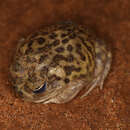Distribution and Habitat
(
Inglês
)
fornecido por AmphibiaWeb articles
Southwest and central zones of Western Australia.The extent of occurrence of the species is approximately 537900 km2
Life History, Abundance, Activity, and Special Behaviors
(
Inglês
)
fornecido por AmphibiaWeb articles
Found on impervious soils that are lightly vegetated.Opportunistic breeder emerging and spawning after heavy rainfall. Eggs are deposited in pools on clay soil where the water is milky and opaque.
Life History, Abundance, Activity, and Special Behaviors
(
Inglês
)
fornecido por AmphibiaWeb articles
No known declines and extent of occurrence > 20,000km2.ThreatsNone known.Conservation MeasuresNone in place.
Kunapalari frog
(
Inglês
)
fornecido por wikipedia EN
The Kunapalari frog (Neobatrachus kunapalari) is a species of frog in the family Limnodynastidae. It is endemic to Australia. Its natural habitats are temperate shrubland, Mediterranean-type shrubby vegetation, subtropical or tropical dry lowland grassland, and intermittent freshwater marshes.
References

- licença
- cc-by-sa-3.0
- direitos autorais
- Wikipedia authors and editors
Kunapalari frog: Brief Summary
(
Inglês
)
fornecido por wikipedia EN
The Kunapalari frog (Neobatrachus kunapalari) is a species of frog in the family Limnodynastidae. It is endemic to Australia. Its natural habitats are temperate shrubland, Mediterranean-type shrubby vegetation, subtropical or tropical dry lowland grassland, and intermittent freshwater marshes.
- licença
- cc-by-sa-3.0
- direitos autorais
- Wikipedia authors and editors

